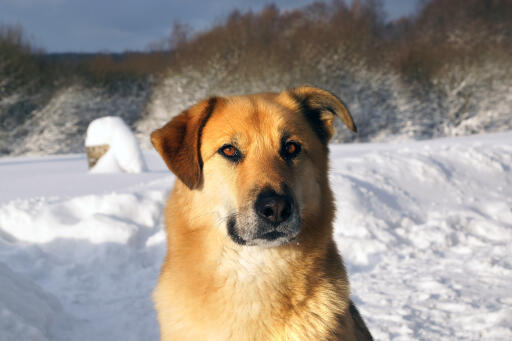Chinook


Geschichte
The bred started life in New Hampshire when Arthur Walden bred his husky with a mastiff type dog to produce a sled pulling dog. In 1917, one puppy named Chinook became the stud dog for all future generations at the time. They were excellent at pulling sleds and were used in Byrd's 1929 Antarctic expedition. Today, they are still a rare brerd with fewer than 100 puppies being born annually. They are mostly kept as pets, but some are used by hobby sled enthusiasts.
Verhalten
The Chinook is a calm, friendly and eager to please dog. They make good pets and are wonderful with children if raised together. They can also live with cats and other dogs if brought up with them from a young age. They can be very wary of strangers and sometimes quite protective with their family if newcomers enter the house. Early socialisation should prevent this and give you a well rounded dog. They shouldn't be shy and are rarely aggressive towards people. They are mellow within the home and will want to sit on your lap given half a chance. Chinooks like to learn and please you. Training is relatively straight forward as they need and want to learn. They work well individually, but excel working in a pack. That pack can be with other breeds or as a family member. They love company and are best kept with another dog or someone who is home for much of the day. They were bred to pull, so lead training can be challenging. They will want to pull you over, so you need to concentrate on this first of all. They can be quite vocal and make a variety of noises from barks, whining and mini howls, so the 'quiet' command should be second on your list. Having said that, the Chinook is an attentive breed and does very well with sledding, agility and obedience training; their desire to learn makes them responsive to your commands and a joy to watch when performing. Chinooks are an active breed that need daily exercise. They like to run and make ideal jogging partners that will be able to run further than you can. Recall is not usually a problem, so they can be walked off lead in a safe environment. They are friendly with other dogs if used to them and puppy training is recommended for social skills. They like to dig and make a hole for themselves to nap in. This can be detrimental to a garden, so it's best to give them a special area to dig that is just for them.
Their short coat is easy to maintain, apart from the twice yearly moult that will require a lot more brushing. Like many rare breeds the gene pool is limited so hereditary issues can arise. Checking the pedigree carefully when getting a puppy will iron out most problems, but the number of Chinooks is very limited. Epilepsy and Canine Hip Dysplasia can be seen in some adults.
Charakter
Chinooks have a very sociable, loving temperament. They are very good with children, particularly if brought up with them through puppyhoood. They are bred for sled pulling and this means that they love to run and explore. That said they are not a workaholic and will try their best to cuddle up to you on the sofa at almost any chance.
Gesundheitliche Probleme
Health problems that may affect Chinooks include canine hip dysplasia (CHD), patellar luxation (dislocation of the knee cap) and some other hereditary problems due to their narrow gene pool.
Einzelheiten zur Rasse
- Status: Selten
- Lebenserwartung: 12 - 15 years
- Produktgewicht: 25 - 41 kg
- Höhe: 21 - 27"
- Selten: Ja
- Fell: Klein - Zweifach
- Pflegeanforderungen: Mehr als einmal pro Woche
- Stadt oder Land: Land
- Mindestanforderungen an Umgebung: Kleines Haus
- Mindestanforderungen an Garten: Kleiner bis mittelgroßer Garten
- Rassetyp: Arbeitshund
- Version: Größe L
- Energieniveau: Größe M
- Benötigte Bewegung: Mehr als zwei Stunden






